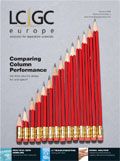A Mass Spectrometry Primer: Part 2
LCGC Europe
Part 2 of this three-part series focuses on comparing operation and performance of the most well known mass spectrometers.
This month's column continues with Part 2 of the three-part series, "A Mass Spectrometry Primer". To recap the basis for undertaking this work, technological changes that affect our knowledge, in terms of its depth and our speed of accessing it, spurs a couple of observations about print media versus electronic. Anything published must be scholarly because it often serves as a primary resource for certain facts, equations and other things we can't, or won't, remember. Paradoxically, almost as soon as we commit words to describing or explaining a fast-developing area of technology, their value diminishes as new insights form. And though the marvels of electronic communication are considerable, they nevertheless fail to resolve all of print's shortcomings as a static medium. For example, increasingly ubiquitous web logs are usually narrowly focused and are posted by a single individual. We have yet to benefit from the deeper understanding of our science that interactive conversations could bring.
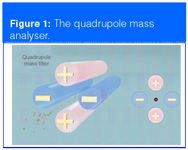
Figure 1
As for primers, they abound in various forms and various authors and some are referenced here. But this primer, which lives on the internet, differs from all others. It is a self-validating document, continually updated with the comments and suggestions of American and European scientists. Please feel free to post your observations on this electronic primer, which you can access by visiting the Waters website at www.waters.com and then clicking Resource Library > Primers.
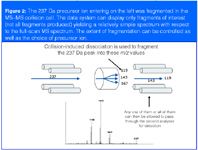
Figure 2
Contents of Part 2
What Types of Instruments Are in Use?
The analyser: the heart of a mass spectrometer
- Quadrupoles and magnetic sectors — Fragmentation
- Ion traps and other non-scanning instruments — Fast-Fourier transform ion cyclotron — Time-of-flight
- Hybrids — Quadrupole time-of-flight — Ion mobility
- Data Handling — Data output, storage and retrieval.
A Brief History of Mass Spectrometry
- 1897: Modern mass spectrometry (MS) is credited to the cathode-ray-tube experiments of J.J. Thomson of Manchester, UK.
- 1953: Wolfgang Paul's invention of the quadrupole and quadrupole ion trap earned him the Nobel Prize in physics.
- 1968: Malcolm Dole developed contemporary electrospray ionization (ESI) but with little fanfare. Creating an aerosol in a vacuum resulted in a vapour that was considered too difficult to be practical. Liquid can represent a volume increase of 100–1000 times its condensed phase (1 mL/min of water at standard conditions would develop 1 L/min of vapour).
- 1974: Atmospheric pressure chemical ionization (APCI) was developed by Horning largely based upon gas chromatography (GC), but APCI was not widely adopted.
- 1983: Vestal and Blakely's work with heating a liquid stream became known as thermospray. It became a harbinger of today's commercially applicable instruments.
- 1984: Fenn's work with ESI was published leading to his Nobel Prize-winning work published in 1988.
For more historical detail, see www.masspec.scripps.edu/mshistory
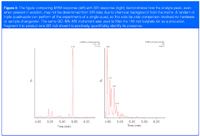
Figure 3
What Types of Instruments Are in Use?
In MS, the ability to exercise control over experiments is supremely important. After an ion is created under carefully controlled conditions, it must be detected as a discrete event with appropriate sensitivity. The minimal vapour load made GC an ideal early choice as a hyphenated technology but only for 20% of compounds. Today, we most frequently aerosolize liquid chromatography (LC) eluent as the means of introducing analytes for ionizing within a mass spectrometer, a technique that requires a vacuum environment to ensure control. An important design element of any mass spectrometer is pumping capacity. Vacuum must be well-distributed in the rarified atmospheric regions of an instrument and it must be sufficient enough to offset such design necessities as the size of the ion inlet and the amount of vapour needing removal.
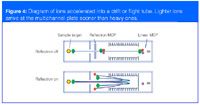
Figure 4
LC–MS pumping requirements depend upon the interface used. Ultimately, this was one of the reasons spurring development of the atmospheric pressure ionization (API) source where the vapour is removed before entry to the MS.
The analyser: the heart of a mass spectrometer: The analyser is an instrument's means of separating or differentiating introduced ions. Both positive and negative ions (as well as uncharged, neutral species) form in the ion source. However, only one polarity is recorded at a given moment. Modern instruments can switch polarities in milliseconds, yielding high-fidelity records even of fast, transient events similar to those typical of ultrahigh-pressure liquid chromatography (UHPLC) or GC separations in which peaks are only about 1 s wide.
Quadrupoles: In 1953, the West German physicists Wolfgang Paul and Helmut Steinwedel described the development of a quadrupole mass spectrometer. Superimposed radio frequency (RF) and constant direct current (DC) potentials between four parallel rods were shown to act as a mass separator, or filter, where only ions within a particular mass range, exhibiting oscillations of constant amplitude, could collect at the analyser.
Manufacturers of today's instruments target them for specific applications. Single-quadrupole mass spectrometers require a clean matrix to avoid the interference of unwanted ions and they exhibit very good sensitivity.

Figure 5
Triple quadrupoles, or tandem mass spectrometers (used for MS–MS) add to a single-quadrupole instrument an additional quadrupole, which can act in various ways. One way is simply to separate and detect the ions of interest in a complex mixture by the ions' unique mass-to-charge ratio (m/z). Another way that an additional quadrupole proves useful is when it is used in conjunction with controlled fragmentation experiments. Such experiments involve colliding ions of interest with another molecule (typically a gas such as argon). In such an application, a precursor ion fragments into product ions and the MS–MS instrument identifies the compound of interest by its unique constituent parts.
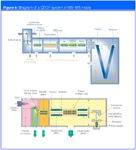
Figure 6
The quadrupole analyser consists of four rods, which are usually arranged in parallel and made of metal such as molybdenum alloys. A tremendous amount of art and science has been invested in developing quadrupole design. Masses are sorted by the motion of their ions, which DC and RF fields induce into an instrument's analyser. Systematically changing the field strength via the operating software in effect alters which m/z value is filtered or transmitted through to the detector at any given time. Quadrupoles yield a lower resolution than some mass spectrometer designs such as TOF instruments. Yet quadrupoles are relatively simple, easy-to-use, highly utilitarian instruments that offer a variety of interfaces at a relatively low cost.
Some terminology, defined more fully later in this primer, is necessary for comparing and describing MS capabilities:

Figure 7
Resolving power
Resolving power is often abbreviated as "res" and can be defined as the ability of a mass spectrometer to separate two masses:
- Low res = unit mass = 1000
- Higher or moderate res = 1000–10000
- High res = 10000+
- Very high res = as much as 3–5 million.
A more detailed examination of resolution and how we measure it appears in the section "Mass Accuracy and Resolution".
Exact mass of an analyte: Sometimes referred to as accurate mass measurement, the exact mass is the measured mass value relative to its theoretical mass that is accurate enough to apply to deducing elemental composition. Commonly accepted criteria for exact mass work (for instance, to publish in a journal or file a patent) is the ability to derive a measurement on an instrument within 5 ppm of its theoretical mass: 5 ppm at 250 Da is 1.25 mDa (not to be confused with 5 mDa, which would be 20 ppm at 250 Da).
MS–MS: Describes a variety of experiments, including multiple-reaction monitoring (MRM) and single-reaction monitoring (SRM). That is, monitoring the transition of precursor ions, or fragmentations, to product ions, which in general tend to improve the selectivity, specificity and sensitivity of detection over a single-stage-instrument experiment. Two mass analysers in series, or two stages of mass analysis in a single instrument are used.

Table 1
In a triple-quadrupole mass spectrometer, there are three sets of quadrupole filters, although only the first and third function as mass analysers. More recent designs have differentiated the middle device sufficiently (replacing the quadrupole of earlier designs), adding increased function so the term or tandem quadrupole is often used instead. The first quadrupole (Q1), acting as a mass filter, transmits and accelerates a selected ion towards Q2, which is called a collision cell. Although in some designs, Q2 is similar to the other two quadrupoles, RF is imposed on it only for transmission, not mass selection. The pressure in Q2 is higher, and the ions collide with neutral gas in the collision cell. The result is fragmentation by collision-induced dissociation (CID). The fragments are then accelerated into Q3, another scanning mass filter, which sorts them before they enter a detector.
Fragmentation: CID, also referred to as collisionally activated dissociation (CAD), is a mechanism by which molecular ions are fragmented in the gas phase, usually by acceleration by electrical potential to a high kinetic energy in the vacuum region followed by collision with neutral gas molecules such as helium, nitrogen, or argon. A portion of the kinetic energy is converted or internalized by the collision, which results in chemical bonds breaking and the molecular ion is reduced to smaller fragments. Some similar "special purpose" fragmentation methods include electron-transfer dissociation (ETD) and electron-capture dissociation (ECD).
Endosulphan-β Product Ion Spectrum
In some regulated industries, to meet the specification for positive compound identification, MRM transitions count for 1.5 "identification points", whereas SIR traces count for 1.0. So, assuming sufficient selectivity, to achieve 3 "IPS", you need two MRM transitions but three SIR traces.
Magnetic sector, or a sector field mass analyser, is an early instrument design that persists today, albeit minimally (having been displaced by modern ESI instruments that can operate in the ESI ionization mode).
Sectors bend ions in arc-shaped trajectories. The ions' "momentum-to-charge" ratios determine the radius of the trajectories, which themselves are determined by an electric or magnetic field. Ions with larger m/z ratios proceed through longer paths than those with smaller ones. The paths are controlled by varying the strength of the magnetic field. Double-focusing mass spectrometers combine magnetic and electric fields in various combinations, although the electric sector followed by the magnetic is more common. This earliest of hybridizations uses the electric sector to focus ions by their kinetic energy as they exit the source. Angular focusing preceded by energetic focusing yields separations of ions with the same nominal mass but different chemical formulas.
Ion Traps and Other, Nonscanning Instruments
An ion-trap instrument operates on principles similar to those of a quadrupole instrument. Unlike the quadrupole instrument, however, which filters streaming ions, both the ion trap and more capable ion cyclotron (ICR) instrument store ions in a three-dimensional space. Before saturation occurs, the trap or cyclotron allows selected ions to be ejected, according to their masses, for detection. A series of experiments can be performed within the confines of the trap, fragmenting an ion of interest to better define the precursor by its fragments. Fields generated by RF voltages applied to a stacked or "sandwich" geometry (end-cap electrodes at opposing ends) trap ions in space between the two electrodes. Ramping or scanning the RF voltage ejects ions from their secular frequency, or trapped condition. Dynamic range is sometimes limited. The finite volume and capacity for ions limits the instrument's range, especially for samples in complex matrices.
Ion-trap instruments were introduced in the 1980s. But limitations imposed by the internal ionization scheme used in those early instruments prevented their use for many applications. Only with the advent of external ionization did the instruments become more universally practical.
The ability to perform sequential fragmentation and, thus, derive more structural information from a single analyte (that is, fragmenting an ion, selecting a particular fragment and repeating the process) is called MSn . Ions introduced over short duration such as UPLC and GC chromatographic peaks are not wide enough to allow more than a single fragmentation (MS–MS or MSn . Ion-trap instruments perform MS–MS or fragmentation experiments in time rather than in space, such as quadrupole and sector instruments. So they cannot be used in certain MS–MS experiments such as neutral loss and precursor ion comparisons. Also, in MS–MS operation with an ion-trap instrument, the bottom third of the MS–MS spectrum is lost, a consequence of trap design. To counter the loss, some manufacturers make available, via their software, wider scan requirements that necessitate the switching of operating parameters during data acquisition.
The trap design places an upper limit on the ratio between a precursor's mass-to-charge ratio and the lowest trapped fragment ion, commonly known as the "one third rule". For example, fragment ions from an ion at m/z = 1500 will not be detected below m/z = 500 — a significant limitation for the de novo sequencing of peptides. The ion trap has limited dynamic range, the result of space–charge effects when too many ions enter the trapping space. Manufacturers have developed automated scanning, which counts ions before they enter the trap, limiting, or gating, the number allowed in. Difficulty can still be encountered when a relatively small amount of an ion of interest is present in a large population of background ions.
Because of similarities in functional design, quadrupole instruments are hybridized to incorporate the advantages of streaming quadrupole and ion-trapping behaviour to improve sensitivity and allow on-the-fly experiments not possible with either alone. (Such instruments are sometimes called linear traps or Q-traps). The increased volume of a linear trap instrument (over a three-dimensional ion trap) improves dynamic range.
Ion-trap instruments do not scan as a quadrupole instrument does, so using the single ion monitoring (SIM) or single ion recording (SIR) technique does not improve sensitivity on ion traps as it does on quadrupole and sector instruments.
Fast-Fourier transform-ion cyclotrons (FT-ICR) represent the extreme capability of measuring mass with the ability to resolve closely-related masses. Although impractical for most applications, a 14.5 tesla magnet can achieve a resolution of more than 3.5 million and, thus, display the difference between molecular entities whose masses vary by less than the mass of a single electron.
Cyclotron instruments trap ions electrostatically in a cell using a constant magnetic field. Pulses of RF voltage create orbital ionic motion and the orbiting ions generate a small signal at the detection plates of the cell (the ion's orbital frequency). The frequency is related inversely to the ions' m/z, and the signal intensity is proportional to the number of ions of the same m/z in the cell. At very low cell pressures, a cyclotron instrument can maintain an ion's orbit for extended periods providing very high-resolution measurements.
Sustained off-resonance, irradiation, collision-induced dissociation (SORI-CID) is a CID technique used in FT-ICR MS. The ions are accelerated in cyclotron motion, where increasing pressure results in collisions that produce fragments. After the fragmentation, the pressure is reduced and the high vacuum restored to analyse the fragment ions.
TOF instruments, although developed many years ago, have become the basis for much modern work because of their fast, precise electronics and modern ionization techniques such as ESI. A TOF instrument provides accurate mass measurement to within a few parts-per-million (ppm) of a molecule's true mass. A temporally dispersive mass analyser, the TOF instrument is used in a linear fashion or, aided by electrostatic grids and lenses, as a reflectron. When operated as a reflectron, resolution is increased without dramatically losing sensitivity or needing to increase the size of the flight (or drift) tube.
TOF analyses involve accelerating a group of ions to a detector in a brief burst. The ions exit the source, each having received an identical electrical charge, or potential, from a "pusher" electrode. Each ion's potential accelerates, or fires, it into a very low-pressure tube. Because all similarly charged ions share the same kinetic energy (kinetic energy = 1/2 mv2 where m is the ion mass and v the velocity), those with lower masses evidence greater velocity and a lesser interval before striking the detector. Because mass, charge and kinetic energy determine the arrival time of an ion at the detector, the ion's velocity can be represented as v = d/t = (2KE/m)1/2 . The ions travel a given distance (d) in time (t), where t depends upon m/z. Because all masses are measured for each "push", the TOF instrument can achieve a very high sensitivity relative to scanning instruments.
Today, quadrupole MS systems routinely scan at 10000 Da, or amu, per second. So a comprehensive scan, even one of short duration (an LC or GC peak of 1 s, for instance) would nevertheless capture each ion 10 times or more in each second. The TOF instrument's detector registers ions bombarding the plate within nanoseconds of each other. Such resolution offers the added capabilities of a wide dynamic range and greater sensitivity when compared directly to a scanning instrument such as a quadrupole. Yet the quadrupole instrument is, generally speaking, more sensitive when detecting target analytes in complex mixtures and is, therefore, a better quantification tool typically. Some instruments, such as ion traps, offer a combination of these capabilities. But until the advent of hybrid instruments, no single one could deliver high-order performance in all aspects.
Early matrix-assisted laser desorption ionization (MALDI)-TOF designs accelerated the ions out of the ionization source immediately. Their resolution was relatively poor and their accuracy limited.
Delayed extraction (DE), developed for MALDI-TOF instruments, "cools" and focuses the ions for approximately 150 ns after they form. Then it accelerates the ions into the flight tube. The cooled ions have a lower kinetic-energy distribution than uncooled ones and they ultimately reduce the temporal spread of the ions as they enter the TOF analyser, resulting in increased resolution and accuracy. DE is significantly less advantageous with macromolecules (for instance, proteins > 30000 Da).
Hybrids
The term "hybrid" applies to various mass spectrometer designs that are composites of existing technologies such as double-focusing, magnetic sectors and, more recently, ion traps that "front" cyclotrons. One of the most interesting designs, the quadrupole time-of-flight (QTOF) mass spectrometer, couples a TOF instrument with a quadrupole instrument. This pairing results in the best combination of several performance characteristics: accurate mass measurement, the ability to perform fragmentation experiments and high-quality quantification.
Further evolution has produced the coupling of ion mobility measurements and separations with tandem MS. Ion mobility mass spectrometry (note: I use "IMMS" as an acronym here because imaging mass spectrometry is often abbreviated as IMS) is a technique that differentiates ions based upon a combination of factors: their size, shape and charge, as well as their mass. IMMS devices are commonly used in airports and hand-held field units for rapidly (20 ms) detecting small molecules whose mobility is known: for example, certain narcotics and explosives. When adapted to the higher-order instruments, IMMS provides an orthogonal dimension of separation (to both LC and MS) and some unique, enabling capabilities including these:
- Separation of isomers, isobars, and conformers (from proteins to small molecules) and determination of their average rotational collision-cross section.
- Enhanced separation of complex mixtures (by MS or LC–MS) leading to increased peak capacity and sample clean-up (physical separation of ions, especially chemical noise, and ions that interfere with analytes of interest).
- Performance of CID-IMMS, IMMS-CID, or CID-IMMS-CID and enhancement of the amount of meaningful information that can be gained from fragmentation experiments in structural elucidation studies.
In all three analytical scenarios, the combination of high-efficiency ion mobility and tandem MS can help you overcome analytical challenges that you could not address by other analytical means, including conventional MS or LC instrumentation. The review article by Hill and colleagues cited at the end of this section compares and contrasts various types of ion mobility — mass spectrometers available as of the article's 2007 publication — and describes the advantages of applying them to a wide range of analytes. It targets four methods of ion mobility separation currently used with MS:
- Drift-time ion mobility spectrometry (DTIMS).
- Aspiration ion mobility spectrometry (AIMS).
- Differential-mobility spectrometry (DMS), also called field-asymmetric waveform ion mobility spectrometry (FAIMS).
- Travelling-wave ion mobility spectrometry (TWIMS).
According to the authors: "DTIMS provides the highest IMS resolving power and it is the only (IMMS) method that can directly measure collision cross-sections. AIMS is a low-resolution mobility separation method, but it can monitor ions continuously. DMS and FAIMS offer continuous-ion monitoring capability as well as orthogonal ion-mobility separations in which high-separation selectivity can be achieved. TWIMS is a novel (IMMS) method whose resolving power is relatively low. Nevertheless, it demonstrates good sensitivity and is well integrated into operation of a commercial mass spectrometer."
Coupled with MS, ion mobility is also being applied to investigate the gas-phase structures of biomolecules. Pringle and colleagues examine the mobility separation of some peptide and protein ions using a hybrid quadrupole–travelling wave ion mobility separator–orthogonal acceleration time-of-flight instrument. Comparing mobility data obtained from the travelling wave (TWIMS) separation device with that obtained using various other mobility separators indicates that "while the mobility characteristics are similar, the new hybrid instrument geometry provides mobility separation without compromising the base sensitivity of the mass spectrometer. This capability facilitates mobility studies of samples at analytically significant levels."
Data Handling
You can sum the intensities of ions and plot them as a function of time (chromatographic retention time) for a total ion chromatogram (TIC), which looks much like the output of a spectrophotometer such as a UV detector. In the case of MS, one axis represents ion intensity; the other can be time or the digital sample taken at a particular time (that is, a spectrum). You can display each of the spectra separately, much like a series of images acquired by modern digital video cameras that are, in essence, a series of high-speed still-photos.
Simple but very useful techniques are possible: for example, reducing the array of data in a selected ion chromatogram or applying digital filters to reduce noise, as you could by displaying only the most intense peak of each digital sample (a base peak ion chromatogram, or BPI). Data output, storage and retrieval: Software design has become a separate speciality over the years, not simply a means to set acquisition parameters. Today, operating and data systems permit intricate control of an instrument by its operator.
Significantly, the following speciality software packages have evolved:
- Workflow controls such as open access — These packages enable qualified individuals with administrative privilege and responsibilities to limit the operations that nonspecialists can perform. For example, a nonspecialist might be permitted to use an instrument only for determining a compound's identity or purity. The system allows them access without first becoming proficient operators themselves.
- Data reduction applications — These packages can help identify metabolites or develop biomarkers in complex mixtures from the thousands of unique chemical entities. The applications are often augmented by "expert" systems such as principal component analysis (PCA) software, which examines trends not otherwise visible in the extensive output.
The demands of data management are fast outstripping the ability to meet them. High-resolution, mass-accurate data can generate a prodigious 1 GB/h. Such enormous quantities of data are generated not only by life science investigators but, increasingly, by those working in industries that depend upon high-volume processes such as characterizing the presence of metabolites and their biotransformations. After 180 days of operation, five mass spectrometers, each producing 24 GB of data per day, will present you with the need to store, retrieve, sort and otherwise make sense of 21.6 terabytes (TB).
The first question in any data scenario must address what we intend to do with the data we collect. Unlike e-mail, which imparts its message and thereafter serves little purpose, on-line data increases in value over time as biological, pharmaceutical and physicochemical measurements continue to amass within a data file. But this increase in value comes with the cost of ensuring the data's accessibility. In view of the increasing size of data files and the length of time over which they must be accessed, a solution might include some form of hierarchical storage management. Thus, some smaller percentage of the data would be accessible immediately (or considered "active"), while the remainder, in successive stages, are in-process or earmarked for long-term archiving.
In the next instalment of "MS — The Practical Art", Part 3 of this series will cover topics such as mass accuracy and resolution, interpreting output, quantification and calibration and solvents for LC–MS. It will also include a glossary.
"MS — The Practical Art" editor Michael P. Balogh is principal scientist, LC–MS technology development at Waters Corp. (Milford, Massachusetts, USA); an adjunct professor and visiting scientist at Roger Williams University (Bristol, Rhode Island, USA); and a member of LCGC Europe's Editorial Advisory Board. Direct correspondence about this column to LCGC Europe, Advanstar House, Park West, Sealand Road, Chester CH1 4RN, UK or e-mail: amatheson@advanstar.com
Silvia Radenkovic on Building Connections in the Scientific Community
April 11th 2025In the second part of our conversation with Silvia Radenkovic, she shares insights into her involvement in scientific organizations and offers advice for young scientists looking to engage more in scientific organizations.

